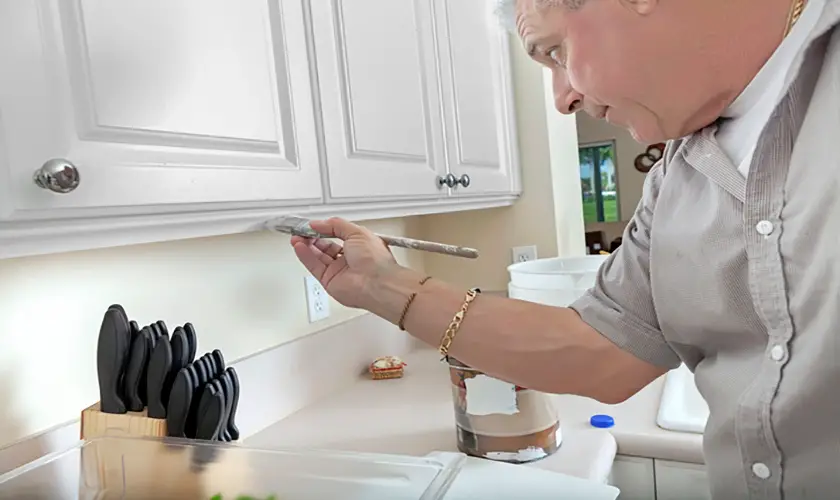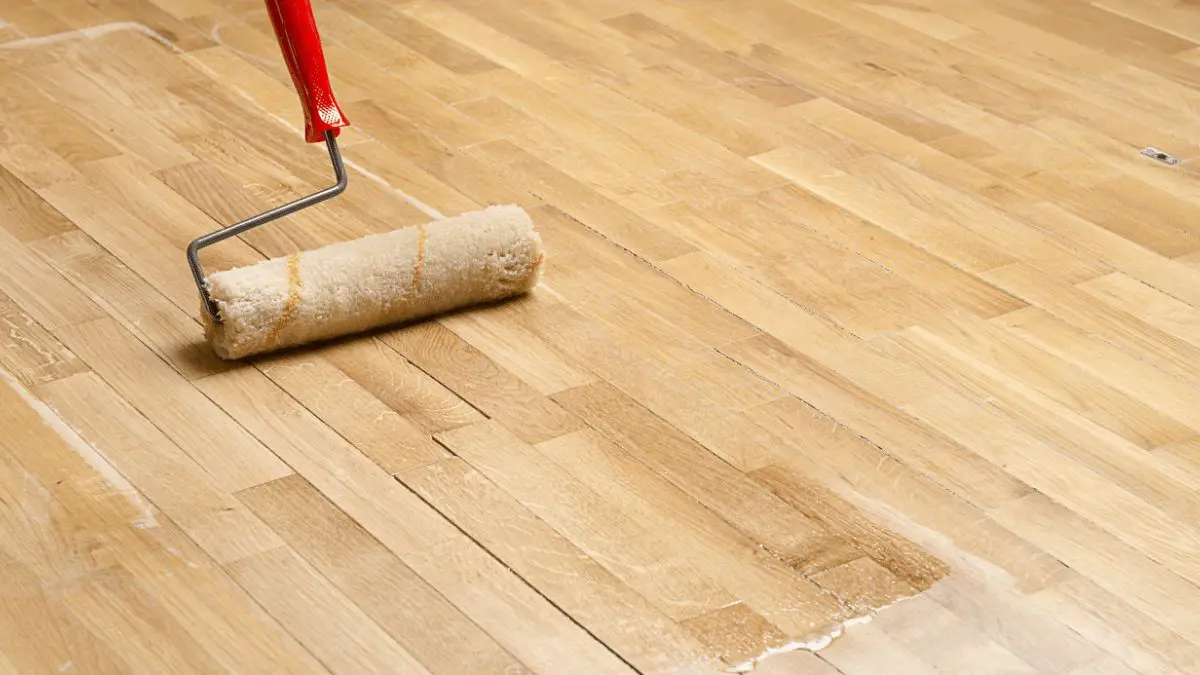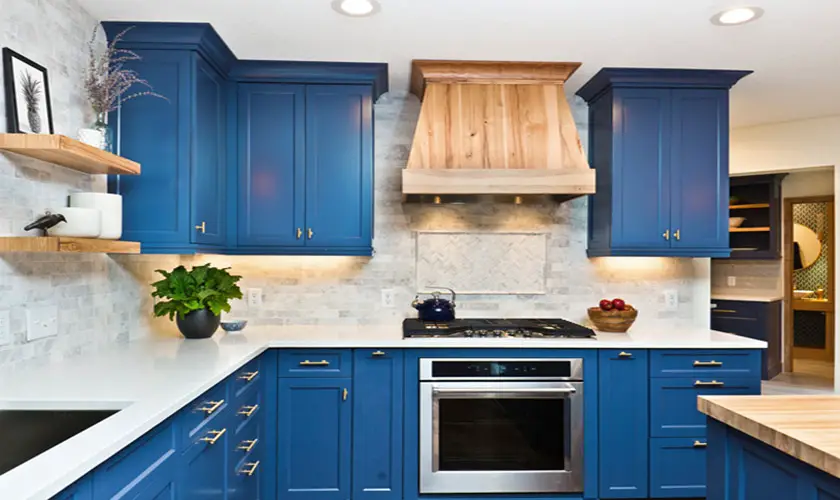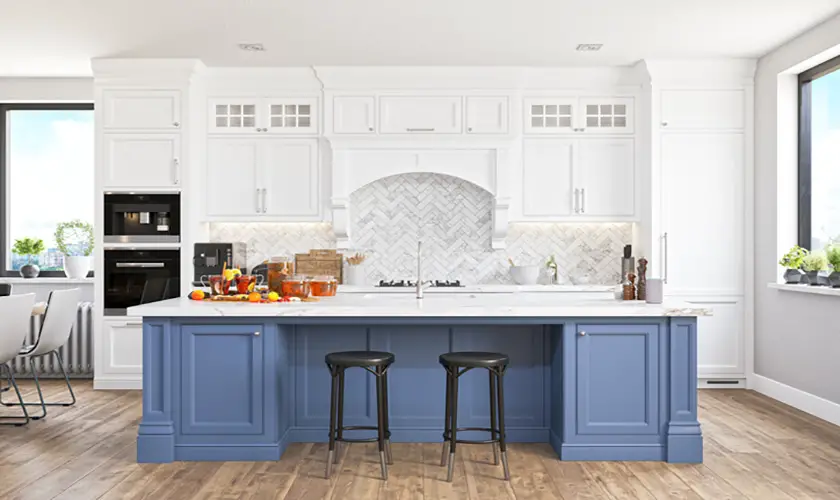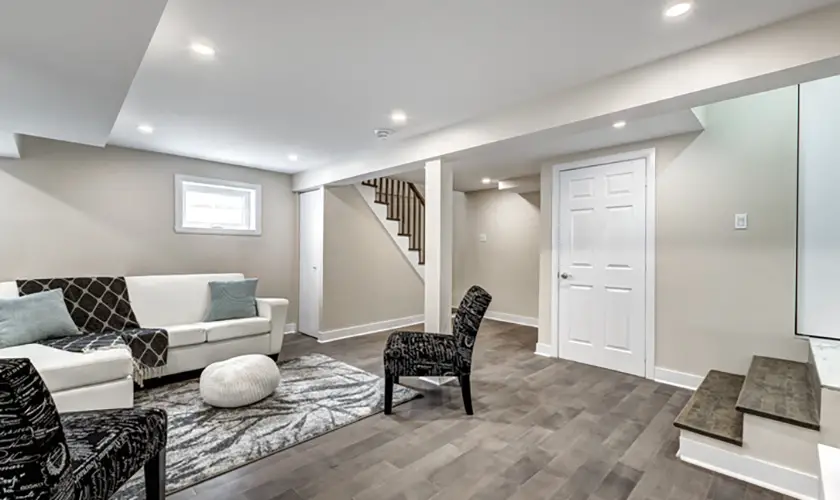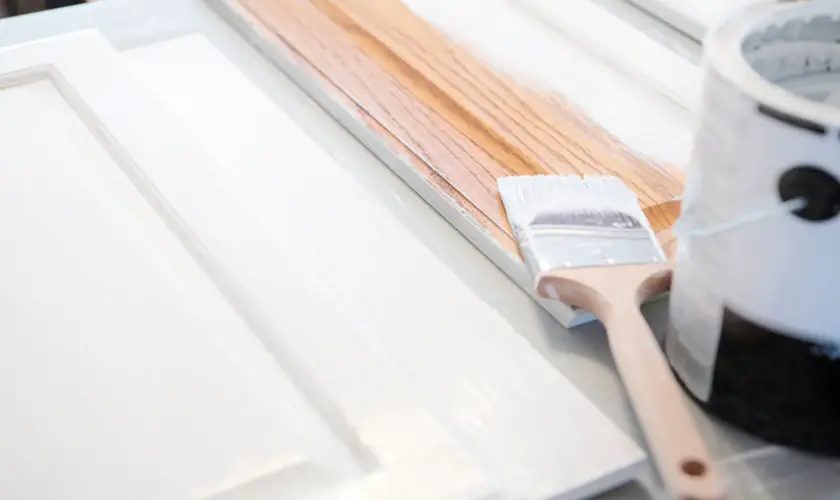
There are few better ways to improve the value and quality of your home than by painting kitchen cabinets white. This is especially true if you have old oak kitchen cabinets that have gone out of style. Rather than spending thousands of dollars on new cabinets, why not spend hundreds by painting kitchen cabinets white for a clean, modern look?
Painting kitchen cabinets white is challenging; however, very possible and something you can do as a DIY project. The key is to take your time, be patient, and take things one step at a time. The biggest mistake is trying to rush things or skip steps. Doing so will lead to improperly painted cabinets, and you’ll have to start all over.
Painting kitchen cabinets white is an excellent way to spruce up your home. You can do it in any room in your house, but kitchens are usually the central area of focus. White cabinets are guaranteed to brighten and liven your kitchen space. If you want to save money and gain DIY painting experience, you’ve come to the right place.
According to Evan Nelson, white kitchen cabinets can benefit people with seasonal affective disorder (SAD).
Is Painting Your Wood Cabinets Expensive?
Painting kitchen cabinets white isn’t free, but it’s much cheaper than installing new ones. New cabinets can cost anywhere from $10,000 to $30,000, depending on your bathroom or kitchen size. On the other hand, DIY painting kitchen cabinets white can cost anywhere from $200 to $1,000, depending on how much paint and supplies you need and the quality of paint you purchase.
Materials You Need to Paint Your Cabinets
Most of the materials you’ll need to transform your cabinets can get purchased at your local paint store. For better prices, however, you should check big box stores like Home Depot or Lowes. Here’s what you’ll need to get started.
- Shop vac
- Tack cloth
- Cleaning supplies
- Painters tape
- Spackling
- Caulk
- Small putty knife
- 120-grit sandpaper
- 220-grit sandpaper
- 320-grit sandpaper
- High-quality paintbrush and roller
- Primer
- Paint sticks
- Paint (We recommend Benjamin Moore)
All in all, your supplies will cost around $200 to $500, depending on how much paint and primer you need to purchase.
How to Paint Kitchen Cabinets White: A Step-by-Step Process
Once your supplies are gathered together, you’re ready to begin painting kitchen cabinets white.
Remove the Cabinet Doors
The first step in painting kitchen cabinets white is always to remove the doors. The only way to get a full coat and not miss any spots is to remove the doors and paint them separately from the cabinets. Set them aside so they don’t get damaged or splashed with paint drops.
Remove the Hinges and Hardware
You should remove any hardware attached to your cabinets and remove the doors and drawers. Hardware includes the pulls, knobs, handles, hinges, and anything else you can think of. While you want to paint your cabinets, doors, and drawers, you don’t want to paint the hardware.
Clean Everything
While cleaning your cabinets is hard work and never fun, it’s an essential step to getting the best finish on your cabinets. You should use a tack rag, and whatever cleaning product gets recommended for your type of wood. Be as thorough as possible and review the cabinets multiple times if necessary.
If you haven’t cleaned your cabinets in a while, you may have to review them twice or even thrice. If you leave even a speck of dust behind, it will show up in your brush strokes.
To Sand or Not to Sand?
No matter how badly you hate sanding, you should always paint wood cabinets. Neglecting to sand your cabinets will result in a sloppy finish where you don’t have a smooth paint job.
If you want to save money, you can sand your cabinets by hand. You should start with 320-grit sandpaper and work your way down to 120-grit. However, hand sanding will take forever if you have many cabinets. It might be worth your while to rent or buy an orbital sander to speed things up. An orbital sander will also ensure a smoother, more even sand job.
Whether you use an orbital sander, you’ll still need to sand tight corners and niches by hand.
Clean and Vacuum Again
Once you’re done sanding, you’ll have a massive mess on your hands. You should first use a shop vac to clean up large clumps of sanding dust, followed by a damp cloth to remove any fine parts. Remember, even the smallest particle of dust can warp your finished product.
Spackle Where Necessary
Depending on the condition of your cabinets, you might need a wood filler to fill significant gaps, crashes, or crevices. Spackling or wood putty is a good option for minor cracks, while paint-friendly caulk is better for more significant gaps.
Prime Before Painting
Regardless of what blog posts say about priming or not priming, you should always prime wood kitchen cabinets before applying paint. Make sure to choose the right type of primer according to the kind of paint you plan to use. Make sure to apply the primer thoroughly and wait several hours before it dries before continuing to the next step.
Check for Defects Before Painting
Once the primer has dried, take some time to check for defects on the wood surfaces. If you still see any gaps or cracks, you must fill them before continuing the painting process. This might mean more spackling or adding more caulk to the equation. Go over all surfaces with a bright light to ensure you don’t miss anything.
Sand Again, if Necessary
Dust or sanding particles may settle on your primer after adding it. If this happens, it will be necessary to do some light sanding on any affected areas. Make sure the primer is completely dry before resanding, or you’ll make a mess of things. When resanding, you should only use 120-grit sandpaper and sand by hand.
Follow the same cleaning process of a shop vac followed by a wet rag to clean any resanded areas thoroughly. Give the dust enough time to settle because you don’t want to repeat the sanding process anymore during your project.
Choose the Right Paint
When painting kitchen cabinets white, the biggest question is what type of paint is the best. Your options are oil-based or latex paint, each with pros and cons. Latex or chalk paint is more popular than it used to be, but oil-based paint is still the choice for pros.
Oil-based paint provides a cleaner, longer-lasting finish that looks better in the long and short run. The upside of using chalk or latex paint is that it’s easier to work with and clean up if you make a mess. Ultimately, however, it’s up to you which type of paint you prefer.
Once you know which type of paint you want, all that’s left to do is choose the shade of white you’re looking for. Make sure to select a shade that goes well with the look of your kitchen, including the walls, floors, and appliances. If you have stainless steel appliances, you might want a darker shade of white.
While cabinets don’t necessarily require special paints, they need high-quality paint for the best results and a smooth finish. Choosing your preferred shade from a trusted name like Sherwin Williams is the way to go.
Paint the Cabinets
It’s always best to start with the upper cabinets and move to the lower ones. That way, if you drip a bit of paint, it won’t mess up the color of the lower cabinets, where you end up with different shades of paint colors.
You can choose between rolling, brushing, or using a paint sprayer when painting kitchen cabinets white. Paint sprayers are quicker and look nicer in the end, but they have a steep learning curve. For this reason, professional painters typically use sprayers, whereas amateurs prefer small rollers or brushes.
Add the Second and Third Coats if Necessary
Depending on the type of paint and application method you choose, it might result in thin coats rather than thick ones. While you’ll always require at least two coats, you might need three or four to get the desired effect and perfect paint job. Give each coat time to dry before adding the ensuing one, and add as many coats as necessary.
Follow the Same Process With Doors and Handles
Once you’re finished with the cabinet boxes, it’s time to move on to the drawer fronts, doors, and cabinet backs. You should follow the same process with these components as you did with the cabinets.
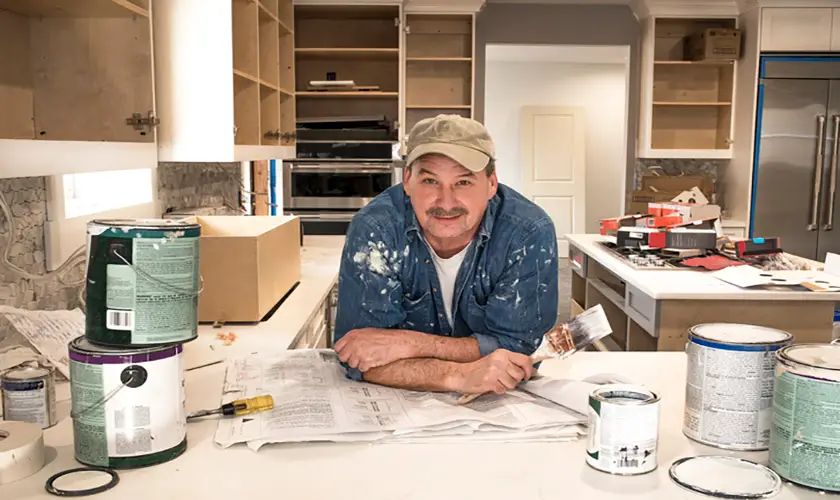
Tips for Successfully Painting Kitchen Cabinets White
Protect Your Countertops and Furniture
No matter how in-depth your painting project will be, it’s a good idea to take protective measures for the rest of your kitchen. Here’s the best way to do that and what it involves.
- Cover your countertops with rags, blankets, or cardboard, so you don’t splash paint on top of them.
- Cover your appliances with rags or plastic wrap to protect them.
- If you don’t plan to change your flooring, you should cover the area near where you’re painting with cardboard or blankets.
- Protect your kitchen island if you’re planning to paint it a different color or not paint it at all.
- Remember, you’re only painting your cabinets and not your entire kitchen.
Label the Doors so You Remember Where They Go
Depending on how many cabinet doors and pieces of hardware you have to remove, it might be worth your while to label them so you remember how to put everything back together correctly.
Make Sure Your Primer is Compatible With the Wood Type
Most people don’t realize that different types of wood require different primers and paints. Oak cabinets are the most finicky of all wood because they have deeper grooves and rivets than other types. As such, they require more prep work and materials than other wood cabinets. Maple cabinets and laminate cabinets, on the other hand, won’t need quite as much prep work.
The main thing to remember when choosing your primer is never to use a latex primer. Even if you use latex or acrylic paint, you should never use latex primer with wood cabinets.
Invest in Quality Tools
Once again, you don’t have to spend a fortune on the best tools and paint products that money can buy. However, you should be willing to splurge on tools and products that are a happy medium between cheap and overpriced. Spending a little extra on the right products and tools, such as paint brushes, rollers, paint, and primer, will make your job easier and your white cabinets nicer.
Don’t Neglect the Backs of the Cabinets.
One of the biggest rookie mistakes is neglecting to paint your cabinet backs. You’ll think about how off they look when you open your cabinet doors and regret not painting them. Having a quality kitchen and a finished product means thoroughly painting every part of your cabinets, including the details you can’t always see.
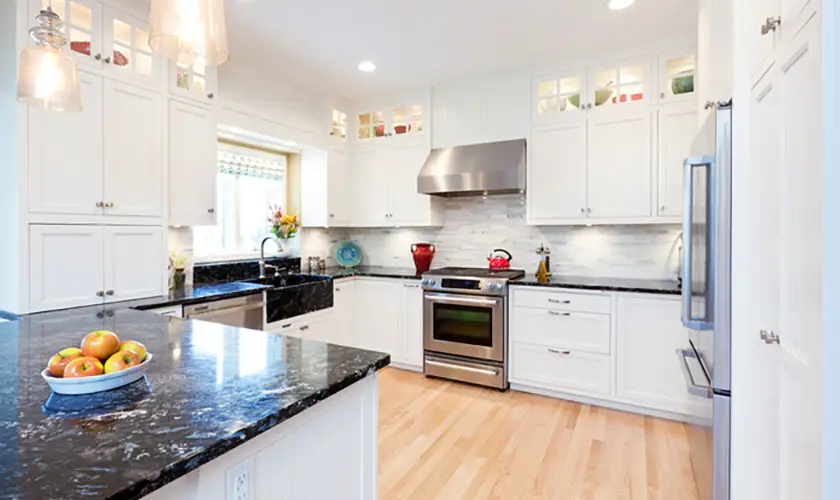
Painting Kitchen Cabinets White FAQs
Is painting kitchen cabinets white a good idea?
Painting kitchen cabinets white can be a good idea to make your kitchen look brighter and more spacious. White cabinets can also help reflect light and make your kitchen appear more spacious.
Can you paint cabinets white without sanding?
You can paint cabinets white without sanding them first, but it’s not recommended. Sanding will help to create a smooth surface for the paint to adhere to and will also remove any grease or grime that might be on the cabinets. If you choose not to sand, use a degreaser and cleaner on the cabinets before painting kitchen cabinets white.
What kind of paint is best for kitchen cabinets?
The best paint for kitchen cabinets is high-quality latex paint in a semi-gloss finish. Latex paint is durable and easy to clean, making it ideal for cabinets that will see a lot of use.
Can kitchen cabinets be painted professionally?
Yes, kitchen cabinets can be painted professionally. Painting kitchen cabinets white is a challenging task that requires precision and expertise. If you’re not confident in your ability to paint cabinets correctly, it’s best to hire a professional painter to do the job for you.
Professional painters will have the experience and knowledge necessary to ensure that your cabinets are painted correctly and look their best.
Should I DIY kitchen cabinet painting?
That depends on your skill level and comfort level with painting. If you’re not confident in your ability to paint cabinets correctly, it’s best to hire a professional painter to do the job for you.
Professional painters will have the experience and knowledge necessary to ensure that your cabinets are painted correctly and look their best. However, if you’re comfortable with the painting and confident in your abilities, painting kitchen cabinets white can save you money.
Can you paint directly over wood cabinets?
While it’s tempting to save time and cut corners by painting directly over wood cabinets without prep work, it’s a mistake. You should always take time to sand, spackle, and prep your cabinets before painting over them. You should also include a layer or two of primer so the paint will adhere to the wood.
Is it better to spray or roll kitchen cabinets?
Professional painters prefer to spray paint kitchen cabinets because it’s faster and provides a smooth finish. However, because of the learning curve and cost involved with spraying, novices should use paint brushes and rollers for the best results.
Final Thoughts
Painting kitchen cabinets white is one of the best things you can do to brighten your kitchen. While it’s a lot of work and will take time and money, you’ll feel happy and rewarded. As long as you follow the steps in this article and adhere to the tips and tricks we’ve laid out, you should have no trouble properly painting wood cabinets white.


